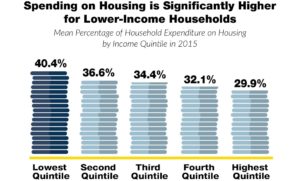
Most Americans know that there are serious gaps between what housing costs and what people can afford in many communities across the country. Many know this first hand from their struggles to make their rent or mortgage payment each month, others know it secondhand from watching friends and families struggle and others simply hear the periodic news stories about how housing costs in New York City or San Francisco have reached new highs.
Despite a general and widespread acknowledgement that affordable housing challenges exist for some, most policymakers and members of the public are not aware of how dramatic the gaps are between what people earn and what they’re able to afford, particularly outside of high-cost regions. NHC’s recent webinar,“Paycheck to Paycheck: More than Housing,” explored these housing affordability gaps. Few people think about low-cost Midwestern metro areas like Gary, Indiana, or Detroit, Michigan, as being places where workers face serious housing affordability challenges, yet for many, they are.
The webinar also shared these key findings from NHC’s recent supplement to the data tool, “More than Housing:”
- Housing costs comprise a significantly higher percentage of income for lower-income households compared to higher-income households.
- Low-income renters spend relatively more of their income on housing than low-income homeowners.
- Both renters and owners are more likely to encounter major housing affordability challenges in and around major cities along the East and West Coasts.
As discussed during the webinar, the housing affordability picture changes when you look at typical earnings and housing costs in the context of other household costs. Many working households are not able to make ends meet when you add up all their expenses. For example, a Colorado family of four with a combined monthly income of $4,749 could fall short of paying for necessary household expenses by $1,032 each month. The Paycheck to Paycheck data tool and the “More than Housing” supplement are important tools to help policy makers and the public visualize how incomes often fall well short of what households need in order to afford their rent or mortgage, along with food, transportation, health care and more. I hope this knowledge can spur more thinking about the role communities should play in ensuring there is affordable housing for workers across a spectrum of incomes.


